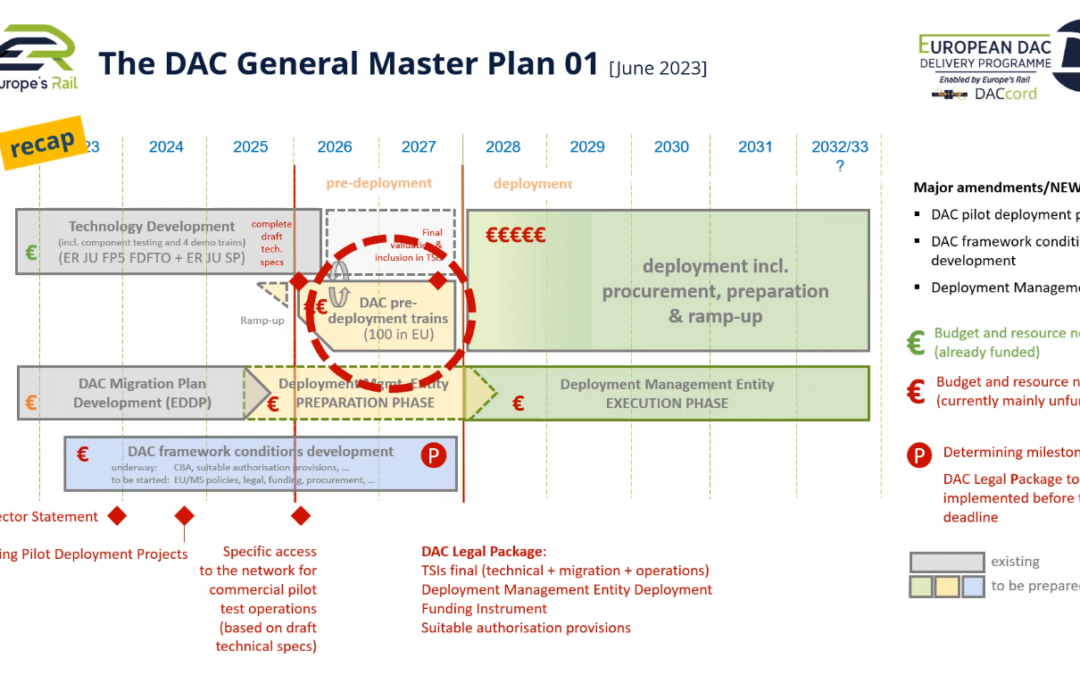Politicians are adapting the framework conditions for the migration to digital automatic coupling (DAK) and the technology for the future standard is being defined step by step. Switzerland is harmonising its introduction process with that in Europe. As industry players, we at the VAP want to drive forward the authorisation for commercial transport and are therefore taking on a key role in the coordination and documentation of the corresponding projects.
That’s what it’s all about:
- Council of States gives green light for DAK and single wagonload transport
- GüTG harmonised with European timetable
- Technology must prove itself as a standard
- Swiss industry takes on pioneering role
- Two stages, one goal: networking with the future
- VAP transforms experience into practical solutions
Council of States gives green light for DAK and single wagonload transport
The developments surrounding the digitalisation of rail freight transport are literally running on several tracks. A course was set in the political process on 24 September 2024. On this day in the autumn session of the Swiss parliament, the Council of States discussed the total revision of the Freight Transport Act and approved the CHF 180 million credit commitment for the introduction of the DAK as well as the CHF 260 million credit commitment for the modernisation of single wagonload transport. The First Council has thus taken up the most important key points of the Federal Council’s dispatch of 10 January 2024 and, with a broad majority, has explicitly spoken out in favour of the digitalisation of freight transport with the innovation that has been refined over many years. Federal Councillor Albert Rösti said in his speech to the full Council: «In addition to digital automatic coupling, further concrete modernisation steps should be taken, such as booking platforms.» We explain why this comment reflects a holistic perspective on the DAK in our blog post «Data ecosystems: Industry round table with Federal Councillor Rösti» .
GüTG harmonised with European roadmap
The planning of the revised GüTG and the corresponding ordinance harmonises with the European roadmap. They are expected to come into force between the end of 2026 and the beginning of 2027. The budgeted federal funds for DAC migration will then be available. The stakeholders of the European DAC Delivery Programme (EDDP) of Europe’s Rail want to roll out DAC migration on a large scale from 2028. This implementation programme brings together railway undertakings, infrastructure managers, wagon keepers and the rail supply industry, maintenance bodies, industry organisations, rail research centres and political institutions. This integrated joint programme builds on research and development results and pilot projects and aims to ensure the necessary measures for a rapid, technically and economically feasible Europe-wide DAC roll-out.
Technology must prove itself as a standard
In order to achieve this ambitious goal, a developed and operationally proven technology is required. Here, too, the EDDP has already done considerable groundwork and communicated the «DAC Basis Package» as the future system standard for European rail freight transport at the beginning of 2024. The EDDP envisages pilot trains throughout Europe to refine and comprehensively test the technology of the «DAC Basis Package». The starter package contains the following components:
- DAC (mechanical/pneumatic) including energy/data system
- Recognising the train composition
- Automatic brake test
- Train completeness test
- Automatic uncoupling (in the train from the locomotive or from the carriage side)
An important system decision is still pending: For the data transmission technology in the train, the options Single via Ethernet and Powerline+ are in the final selection. As successful tests with Powerline+ have already been carried out in Switzerland, a pilot train with this technology that is ready for approval is now to be realised in the near future.
Swiss industry takes on pioneering role
Switzerland wants to make a substantial contribution to the European DAK development project coordinated by the EDDP and coordinate it closely with the EDDP’s European organisations. The Swiss railway industry is therefore preparing to push ahead with system integration for the approval of commercial applications. The technical specifications and functional scope of the «DAC Basis Package» and the Powerline+ transmission technology form the basis for the Swiss project team’s further work. Accordingly, the FOT, VAP and VöV will extend their jointly signed declaration of intent on automation in rail freight transport accordingly.
Two stages, one goal: networking with the future
Switzerland’s contribution to the introduction of DAK will take place in two stages. Firstly, system integration on the Swiss pioneer train is to be driven forward rapidly until it is ready for approval and its suitability for everyday use will then be demonstrated in commercial operations. The federal government will support the development with funding in accordance with Article 10 of the Goods Transport Act.
- The EP3 development project to realise the approval of a first pioneer train with the «DAC Basic Package» functions has begun. The aim is to obtain a FOT operating licence for defined commercial journeys on the Swiss standard-gauge network by mid-2026. To this end, around 30 motivated Swissrail members, SBB Cargo, the FOT and VAP representatives announced their intention on 30 August 2024 to jointly make rail freight transport competitive and promote Swiss DAC technology to the outside world. With EP3, the industry players want to play a key role in defining the future European standard for rail freight transport. It is now time to move beyond fundamental discussions and develop operationally viable solutions. The new systems must be robust, suitable for everyday use and affordable so that goods trains can operate successfully in the future.
- Following the completion of EP3, the EP4 development project aims to bring several DAK trains onto the Swiss rail system for commercial journeys in the period from 2026 to 2027. Initial discussions with shippers have already taken place. Isolated transport operations are being sought that are suitable for an early DAK conversion as pioneer trains. The aim of this second stage is to gather operating experience and further optimisation in real operations. The pioneer trains are intended to give stakeholders and investors involved a concrete picture of the future possibilities with DAC and the associated digitalisation of rail freight transport.
VAP transforms experience into practical solutions
We at the VAP will coordinate and document the aforementioned projects for all interested parties and stakeholders. In this way, we want to ensure a broad exchange of experience and full practicability right down to the sidings and logistics of the economy. Our members – above all the shippers and wagon keepers – are actively involved in both stages of development. In this way, findings from pilot projects can be scaled and synergies can be utilised for all industry players.



